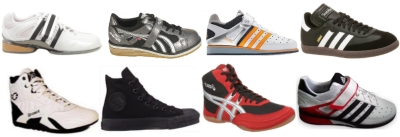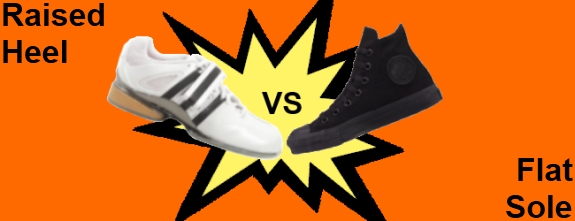Weight lifting shoes?! Who the heck needs special shoes just for lifting weights?…
…Well, you do!

That’s assuming, of course, that you’re serious about reaching your fitness goals…
…You see, proper footwear provides some essential benefits for ensuring your faster and more sustainable progress.
This page is all about weight lifting shoes: I’ll start by telling you which shoes to avoid.
Then, I’ll explain the characteristics of good lifting shoes, and what the differences are between flat-soled and raised-heel shoes.
Lastly, I’ll list my recommendations for the best footwear on the market, and show you where you can buy them.
Benefits of Weight Lifting Shoes
Proper weight lifting footwear is important because it provides these highly desirable benefits:
- Improved Safety. Good footwear will give you noticeably better balance and stability. This will make you less prone to injury, in both the short and the long term.
- Better Technique. The right weight lifting shoes put your body in the most biomechanically efficient positions, so that you can execute given exercises with greater precision and ease.
- Stronger Lifts. It’s amazing how much of a difference that footwear can make in your strength. It’s not unheard of to add 10 or more pounds to your squat when switching from sneakers to weight lifting shoes.
Shoes to Avoid
Before I talk about shoes that you should wear, I’ll talk about the kinds you shouldn’t wear.
It’s actually pretty simple: Avoid all shoes with soft, compressible soles. This includes running shoes, basketball shoes and just about all other kinds of sneakers.
Soft, compressible soles are bad for weight lifting because they don’t provide a stable base from which to lift.
Think about squatting a few hundred pounds and wearing soft-soled shoes – The soles would absorb some of the energy from your force output. This energy would have otherwise been transferred through your body, to be utilized in completing the movement.
Soft-soled shoes also increase the likelihood of injury. This is because the poor stability provided by the soles causes an uneven and erratic weight distribution.
Uneven weight distribution is bad in the long term, as it can breed poor technique habits or cause repetitive motion injuries.
However, there is the risk for injury in short-term, too. For example, a sudden shift in weight distribution could compress the outside of the sole and cause your ankle to roll over. Not fun.
Characteristics of Good Weight Lifting Shoes
Any good pair of weight lifting shoes should provide the following:
- Hard Sole. Your shoes must have a hard, non-compressible sole. This gives you a surface that will be completely stable under hundreds of pounds of pressure. Thus, you can lift heavier because the energy you drive through your feet is not absorbed or misdirected. Rather, all of it is utilized to propel the load up.
- Snug Fit. It is essential that the shoes fit you properly. They should fit snuggly. Not super tight and not flopping around on your feet, either. This gives you proper foot support, which provides lateral (side to side) stability and protects your ankles.
- No-Slip Traction. The shoes must also have some grip to them. This helps you keep your feet firmly planted during exercises like squats, deadlifts and bench. And it prevents you from slipping and falling during Olympic-style exercises like power cleans and snatches.
Raised Heels vs. Flat Soles

The right weight lifting shoe for you depends mostly on the types of lifts you do. Though it also depends on your personal preferences, which are largely determined by your body structure and flexibility. Below, I’ll explain the differences between each type of shoe.
Raised Heels
- Raised heeled shoes are best for the front squat and high bar back squat. They enable you to squat deeper with greater ease, by reducing the amount of ankle flexibility required to maximize squat depth. The raised heel also shifts your hips forward slightly, which places a greater emphasis on the quadriceps during the squat movement.
- Olympic-style lifts (e.g. snatch, clean and jerk, power clean) and overhead movements (e.g. barbell overhead press, overhead squats) are best performed in raised heel shoes, because they allow you to keep your hips further forward and reach greater depth (if applicable).
- Some guys find that raised heels facilitate better leg drive on the bench press.
- The drawback of raised heel shoes is that they are not optimal for deadlift or barbell bent over row. Although it is possible to do deadlifts and barbell rows in these shoes (some trainees actually prefer to do so), the raised heels cause your body to tilt forward when it is already in a bent over, frontward position. This puts you at a biomechanical disadvantage, and may throw you off balance.
Flat Soles
- Flat soled shoes are superior for performing wide stance squats (i.e. low bar squats) they also allow you to “sit back” into the squat and engage your hips, glutes and hamstrings; thereby driving the weight up more efficiently.
- Although raised heel shoes are best for high bar squats, it is still possible to do them in flat-soled shoes. That said, if you have poor ankle and hip flexibility, you won’t be able to reach full squat depth. And if you have good ankle and hip flexibility, you won’t be able to reach full depth as easily and swiftly as you could with raised heel shoes.
- Flat soles give you an advantage when doing deadlifts and Pendlay rows, since they keep you closer to the ground and don’t tilt your body forward.
- While you can still bench and perform overhead movements in flat-soled shoes, they don’t give you the slight performance boost often experienced with raised heel shoes. They are neutral, in this respect.
“I Can’t Decide Between Raised-Heel or Flat-Soled Shoes!”
I understand that it’s hard to decide which type of shoe to buy, even after reading about their differences. I’ll try to help you out by giving my advice on a few different scenarios:
- If you do any Olympic-style lifts (or plan to do so), then you should most definitely go with the raised heel weight lifting shoes. As far as deadlifting goes, you can still do them in these shoes. And if that doesn’t feel right, then simply take them off and deadlift barefoot.
- If you don’t do any Olympic-style lifts, but you do perform wide stance squats, then go with any flat-soled shoe of your choice.
- If money is tight and you’re not really doing any Olympic-style lifts, then go with a pair of flat-soled Converse Chuck Taylor’s (see link below). It’s hard to go wrong with these. They’re the least expensive choice, and they can get the job done.
- If you’ve got money to blow, and you do deadlifts, in addition to high bar squats or some Olympic-style lifts, then you may as well buy both types of weight lifting shoes. This way, you can wear the best suited footwear for each exercise.
The Best Weight lifting Shoes
Below are my top recommendations for wide variety of weight lifting shoe options. Hopefully you see one you like!
Raised Heels:
- Adidas adiPower
- Adidas adiStar
- Adidas Power Perfect
- Adidas Power Lift Trainer
- Pendlay Do-Win Classic
Flat Heels:
- SABO Deadlift Shoes (great overall powerlifting shoes; not just for deadlifts)
- Converse Chuck Taylor
- Adidas Samba Classic
- Otomix Shoes
- Wrestling Shoes
Personally, I workout in Converse Chuck Taylor hi-tops, or barefoot. This has worked out well thus far…
…However, I’m planning on buying a pair of raised heel weight lifting shoes (probably the adiPower) for doing high bar squats, overhead squats and power cleans. After I buy them and use them for a while, I’ll be sure to write a detailed review.

